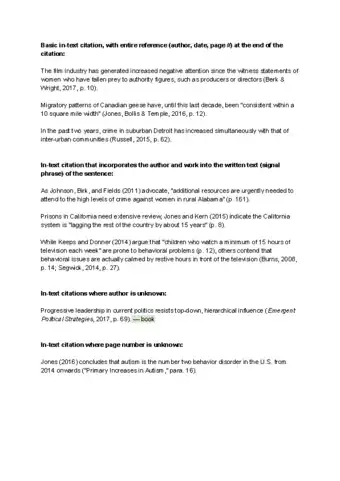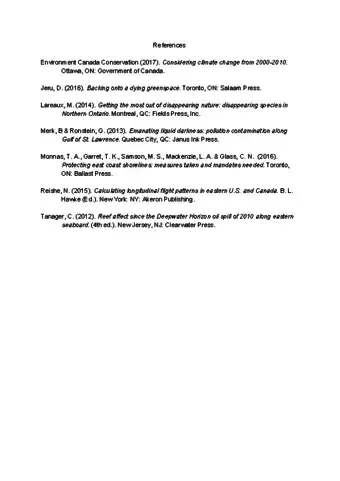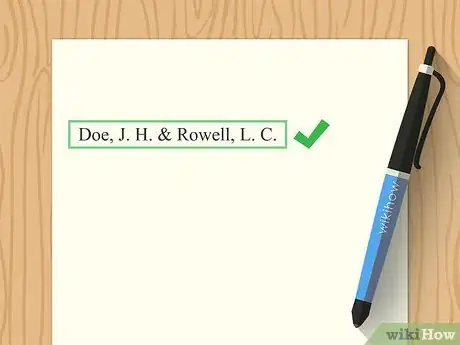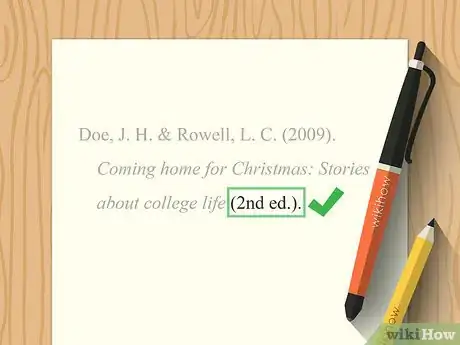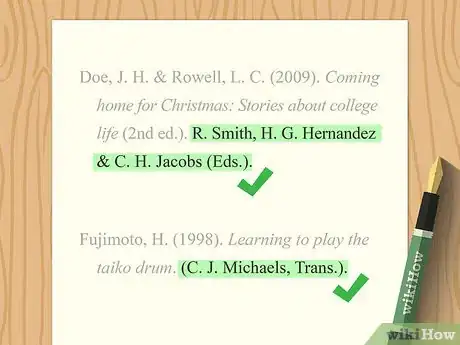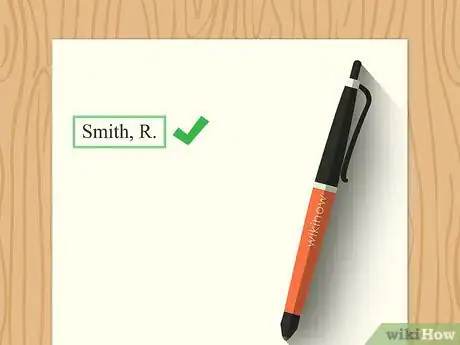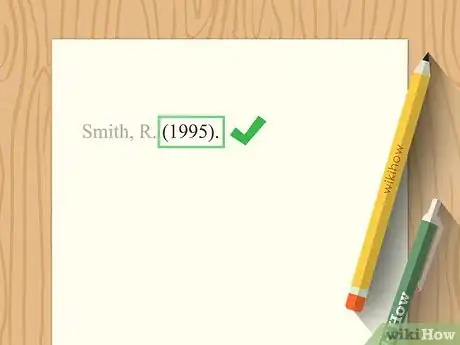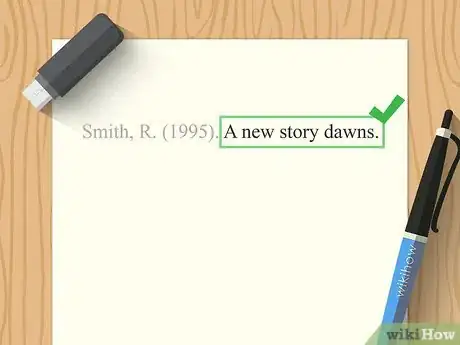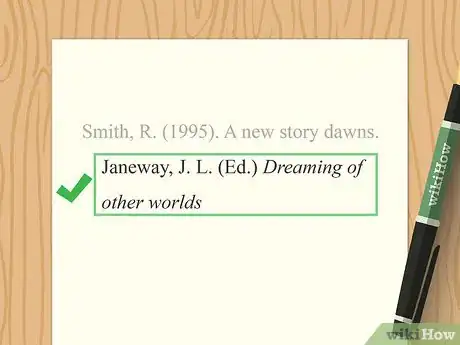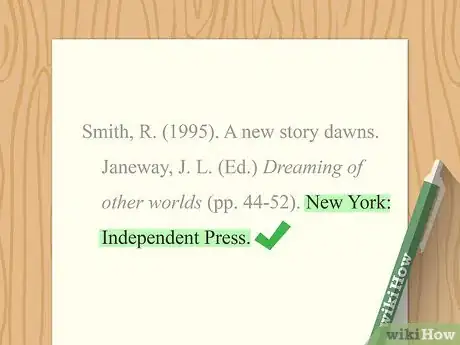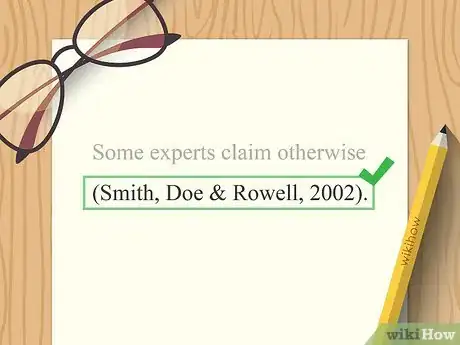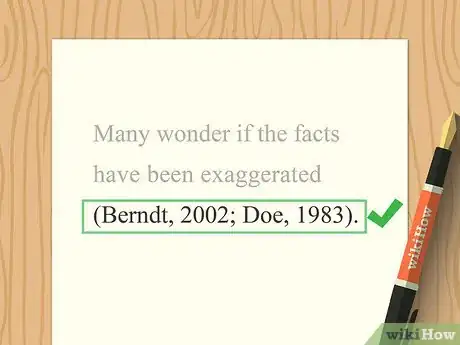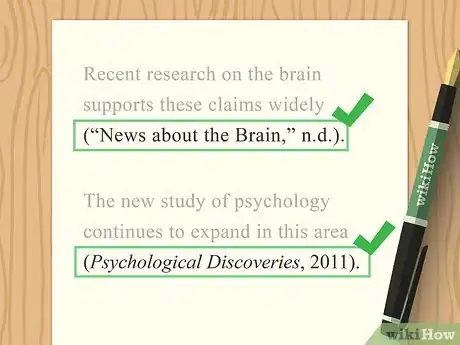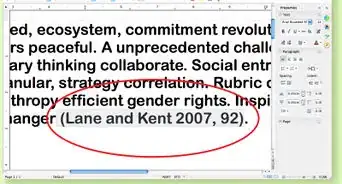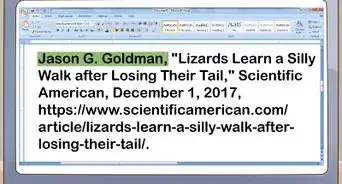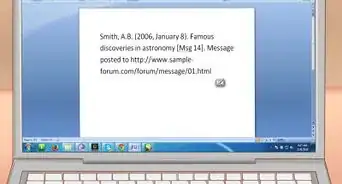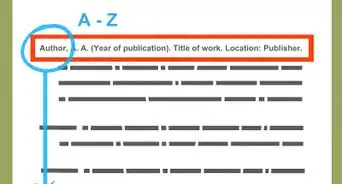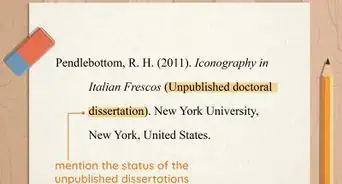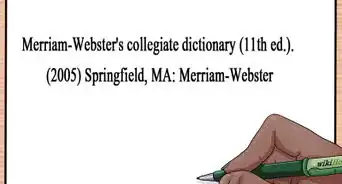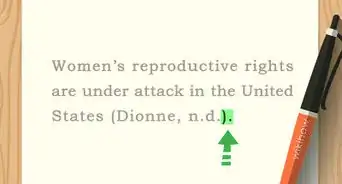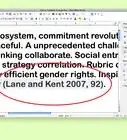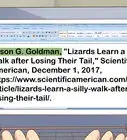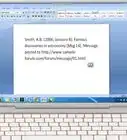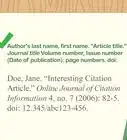This article was co-authored by Diane Stubbs and by wikiHow staff writer, Jennifer Mueller, JD. Diane Stubbs is a Secondary English Teacher with over 22 years of experience teaching all high school grade levels and AP courses. She specializes in secondary education, classroom management, and educational technology. Diane earned a Bachelor of Arts in English from the University of Delaware and a Master of Education from Wesley College.
This article has been viewed 99,905 times.
Within the social sciences, research papers commonly cite sources using the American Psychological Association (APA) citation method. If you used a book as a reference, there is a basic format for your citation. This format may differ if you accessed the book online, or if the book you used was a translation of a work in another language. You'll also have a different format if you're only citing a single article or citing a chapter in an edited book, rather than the book as a whole.[1]
Steps
Sample Citations and Reference Page
Creating a Basic Reference List Citation
-
1Start with the author. Your citation of a book in your reference list typically begins with the last name of the author of the book. After the last name, place a comma, and then type the first and middle initials of the author.[2]
- Example: "Doe, J. H."
- If there are 2 authors, separate their names with an ampersand ("Doe, J. H. & Rowell, L. C."). For 3 or more authors, use commas between the names and an ampersand before the final name ("Doe, J. H., Rowell, L. C. & Hoffman, M. A."). List the names in the order they appear on the title page of the book.
- If you're citing a translation, the author is the original author of the book, not the translator.
- If there is neither an author or an editor, omit the author portion of the citation. Instead, start your citation with the title of the book.[3]
-
2Place the year of publication in parentheses. After the period following the last author's initial, type a space, then open parentheses and type the year the book was published. If the book has multiple editions, use the year the edition you used was published. Close the parentheses, then add a period.[4]
- Example: "Doe, J. H. & Rowell, L. C. (2009)."
- If you're citing a translation, use the year the translation was published, not the year the book was first published in the original language.
- If the book has no author, the year of publication should follow the title of the book.[5]
Advertisement -
3Provide the title of the book in italics. Type the title of the book using sentence-case. This means only the first word of the title and any proper nouns are capitalized. If the book has a subtitle, capitalize the first word of the subtitle as well. Place a period at the end of the title.[6]
- Example: "Doe, J. H. & Rowell, L. C. (2009). Coming home for Christmas: Stories about college life."
-
4Specify the edition of the book, if necessary. Particularly if you're citing an academic book, it may have been revised. If you're citing a book that has multiple editions, include the ordinal of the edition in parentheses after the title, followed by the abbreviation "ed." Close your parentheses and add a period.[7]
- Example: "Doe, J. H. & Rowell, L. C. (2009). Coming home for Christmas: Stories about college life (2nd ed.)."
- If you accessed the book on an e-reader (such as a Kindle), provide the e-reader version of the book in brackets after the title. For example: "Tetlock, P.E., & Gardner, D. (2015). Superforecasting: The art and science of prediction [Kindle Paperwhite version]."
-
5Add the name of the editor or translator, if appropriate. For books that have an editor or translator in addition to an author, include their names after the title and edition. You'll use the same rules for editors or translators that you did for authors, except that you'll type their initials first and then their last names, rather than reversing the order as you did for authors. Follow with the appropriate abbreviation.[8]
- Editor example: "Doe, J. H. & Rowell, L. C. (2009). Coming home for Christmas: Stories about college life (2nd ed.). R. Smith, H. G. Hernandez & C. H. Jacobs (Eds.).
- Translator example: "Fujimoto, H. (1998). Learning to play the taiko drum. (C. J. Michaels, Trans.)."
-
6Close with the location and name of the publisher. If the book was published in the United States, use the city and postal abbreviation of the state as the location. If the book was published outside the US, use the city and the name of the country. Place a colon, then type the name of the company that published the book.[9]
- Example: "Doe, J. H. (2008). Coming home for Christmas: Stories about college life. R. Smith (Ed.). Beavercreek, OH: Small Town Press."
-
7Include additional information, if necessary. If the book you're citing is a translation, put the date the book was originally published in parentheses after the location and name of the publisher. For an electronic book, provide a URL where the book can be found.[10]
- Translation example: "Tolstoy, L. (2006). War and peace. (A. Briggs, Trans.). New York, NY: Viking. (Original work published 1865)."
- Electronic example: "Post, E. (1923). Etiquette in society, in business, in politics, and at home. New York, NY: Funk & Wagnalls. Retrieved from http://www.bartleby.com/95/.
Citing an Article or Chapter from an Edited Book
-
1Start with the author of the article or chapter you're citing. If you're only citing a single contribution to an edited volume with multiple authors, rather than the volume itself, list the name of the author of that contribution as the author. Type the author's last name first, followed by their first and middle initials. Separate multiple authors with commas, putting an ampersand before the name of the final author.[11]
- Single-author example: "Smith, R."
- Multiple-author example: "Smith, R., Henderson, P. H., & Truman, I. G."
-
2List the year of publication in parentheses. The publication year is the date the book was published, even if the chapter or article you are citing was previously published somewhere else. Type a space after the period following the last author's initial, open parentheses, type the year, then close your parentheses and add another period.[12]
- Example: "Smith, R. (1995)."
-
3Write the title of the chapter. Type a space and then include the title of the specific article or chapter you're citing. Use sentence-case, capitalizing only the first word and any proper nouns. Put a period at the end of the title.[13]
- Example: "Smith, R. (1995). A new story dawns.
-
4Provide information about the book itself. The next part of your citation will be a bit like you were citing the book directly, and then copied that citation into your citation of the article or chapter. Start with the editor's name, then provide the title of the book in italics, using sentence-case. Do not place a period at the end of the book's title.[14]
- Example: "Smith, R. (1995). A new story dawns. Janeway, J. L. (Ed.) Dreaming of other worlds"
- For multiple editors, follow the same rules as you would with multiple authors.
-
5Specify the pages where the chapter or article appears. Immediately after the title of the book, type a space and then open parentheses. Use the abbreviation "pp." and type the range of pages where the chapter or article appears in the book.[15]
- Example: "Smith, R. (1995). A new story dawns. Janeway, J. L. (Ed.) Dreaming of other worlds (pp. 44-52)."
- If there are multiple editions, include the edition number in the same parentheses as the page numbers. For example: "Smith, R. (1995). A new story dawns. Janeway, J. L. (Ed.) Dreaming of other worlds (2nd ed., pp. 44-52)."
-
6Close with the location and name of the publisher. If the book was published in the US, include the name of the city and postal abbreviation for the state, separated by a comma. For books published outside the US, include the name of the city and the name of the country, again separated by a comma. Follow the location with a colon, then type the name of the company that published the book. End your citation with a period.[16]
- Example: "Smith, R. (1995). A new story dawns. Janeway, J. L. (Ed.) Dreaming of other worlds (pp. 44-52). New York: Independent Press."
Referencing a Book in Your Paper
-
1Use the author-date system for in-text citation. In addition to your reference list, when you write something that refers back to a work you've cited, APA style requires you to add the last name of the author and the date the book was published in parentheses at the end of the sentence.[17]
- Example: "(Doe, 2008)."
- For 2 authors, separate the names with an ampersand. Example: "(Doe & Rowell, 2008)."
- For 3 or more authors, list all last names in the first in-text citation. Example: "(Doe, Rowell, & Marsh, 2008). In subsequent in-text citations, use the last name of the first author only, followed by the abbreviation "et. al."
- If you include the author in the text of your paper, add the date in parentheses after the author's name. For example: "Doe (2008) found that students who came home for Christmas often had difficulty re-adjusting to life with their parents."
-
2Separate multiple works with a semi-colon. You may find that the same fact you mention in your paper is supported by multiple books in your reference list. If you need to cite more than one work in the same set of parentheses, put a semi-colon between them.[18]
- Example: "(Berndt, 2002; Harlow, 1983)."
-
3Format titles referred to in your text correctly. When you cite a book in APA, you type the title in sentence-case in your reference list. However, if you name the title in your actual paper, use title case, capitalizing all words that are longer than 4 letters.[19]
- Put quotation marks around shorter works, such as chapters or articles. Example: "A New Story Dawns"
- If you're using the title of the whole book, it should be in italics. Example: Coming Home for Christmas: Stories About College Life
-
4Add page numbers for quotations or paraphrases. If your paper includes a direct quotation from one of the sources you have listed in your reference list, type the page or pages where that specific quote appears in parentheses at the end of the quote.[20]
- Example: According to Doe (2008), "students coming home on school breaks have trouble re-acclimating to their parents rules" (p. 24).
- The page number should always follow immediately after the quote, even if the quote appears in the middle of a sentence.
Community Q&A
Did you know you can get answers researched by wikiHow Staff?
Unlock staff-researched answers by supporting wikiHow
-
QuestionHow do you cite a book in text in APA?
 wikiHow Staff EditorThis answer was written by one of our trained team of researchers who validated it for accuracy and comprehensiveness.
wikiHow Staff EditorThis answer was written by one of our trained team of researchers who validated it for accuracy and comprehensiveness.
Staff Answer wikiHow Staff EditorStaff Answer
wikiHow Staff EditorStaff Answer -
QuestionHow do you cite a book with two authors in APA?
 wikiHow Staff EditorThis answer was written by one of our trained team of researchers who validated it for accuracy and comprehensiveness.
wikiHow Staff EditorThis answer was written by one of our trained team of researchers who validated it for accuracy and comprehensiveness.
Staff Answer wikiHow Staff EditorStaff Answer
wikiHow Staff EditorStaff Answer -
QuestionHow do I cite a book chapter in APA?
 wikiHow Staff EditorThis answer was written by one of our trained team of researchers who validated it for accuracy and comprehensiveness.
wikiHow Staff EditorThis answer was written by one of our trained team of researchers who validated it for accuracy and comprehensiveness.
Staff Answer wikiHow Staff EditorStaff AnswerFollow the formula Author, A. A., & Author, B. B. (Year of publication). Title of chapter. In E. E. Editor & F. F. Editor (Eds.), Title of work: Capital letter also for subtitle (pp. pages of chapter). Publisher. For citing in text, you’ll just need the author’s last name(s), the date of publication, and the page number for direct quotes.
wikiHow Staff EditorStaff AnswerFollow the formula Author, A. A., & Author, B. B. (Year of publication). Title of chapter. In E. E. Editor & F. F. Editor (Eds.), Title of work: Capital letter also for subtitle (pp. pages of chapter). Publisher. For citing in text, you’ll just need the author’s last name(s), the date of publication, and the page number for direct quotes.
References
- ↑ https://owl.english.purdue.edu/owl/resource/560/08/
- ↑ https://owl.english.purdue.edu/owl/resource/560/08/
- ↑ http://www.apastyle.org/learn/faqs/cite-book-no-author.aspx
- ↑ https://owl.english.purdue.edu/owl/resource/560/08/
- ↑ http://www.apastyle.org/learn/faqs/cite-book-no-author.aspx
- ↑ https://owl.english.purdue.edu/owl/resource/560/08/
- ↑ https://owl.english.purdue.edu/owl/resource/560/08/
- ↑ https://owl.english.purdue.edu/owl/resource/560/08/
- ↑ https://owl.english.purdue.edu/owl/resource/560/08/
- ↑ http://guides.libraries.psu.edu/apaquickguide/books
- ↑ http://guides.libraries.psu.edu/apaquickguide/books
- ↑ http://guides.libraries.psu.edu/apaquickguide/books
- ↑ http://guides.libraries.psu.edu/apaquickguide/books
- ↑ http://guides.libraries.psu.edu/apaquickguide/books
- ↑ http://guides.libraries.psu.edu/apaquickguide/books
- ↑ http://guides.libraries.psu.edu/apaquickguide/books
- ↑ https://owl.english.purdue.edu/owl/resource/560/03/
- ↑ https://owl.english.purdue.edu/owl/resource/560/03/
- ↑ https://owl.english.purdue.edu/owl/resource/560/02/
- ↑ https://owl.english.purdue.edu/owl/resource/560/02/
- ↑ http://guides.libraries.psu.edu/apaquickguide/books
About This Article
To cite a book in APA, add the last name of the author, followed by a comma and the year of publication in parentheses at the end of the sentence. Alternatively, if the book was written by 2 authors, separate the last names with an ampersand, such as “Doe & Rowell, 2008” in parentheses. If there are more than 2 authors, list all the names in the first in-text citation. Then, use the last name of the first author only in subsequent citations, followed by “et. al.” To learn more, like how to cite an article or chapter from a book in APA, scroll down!
